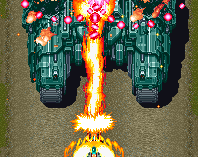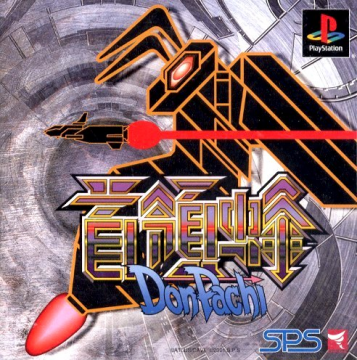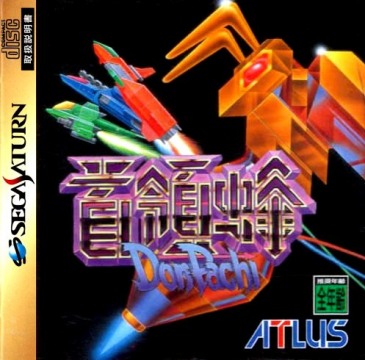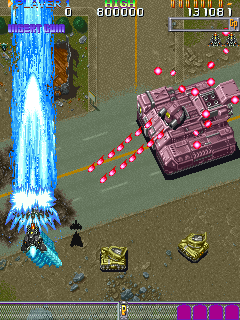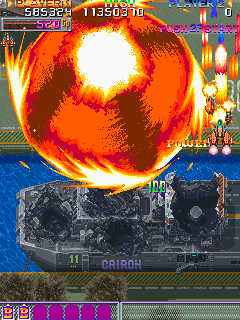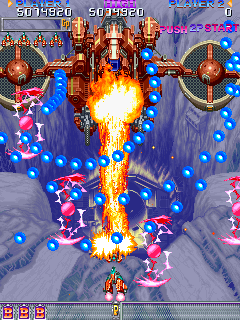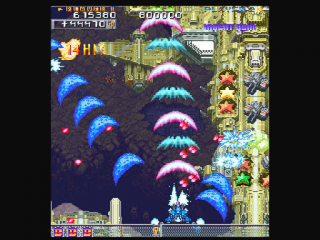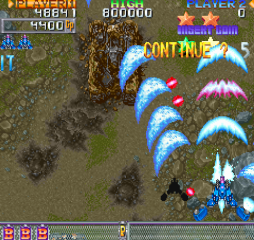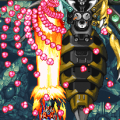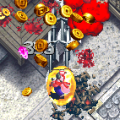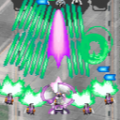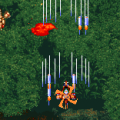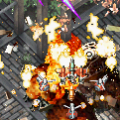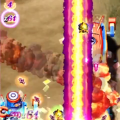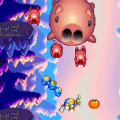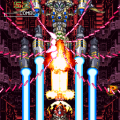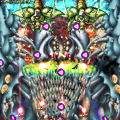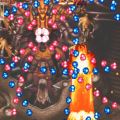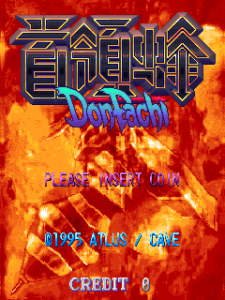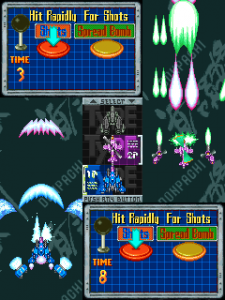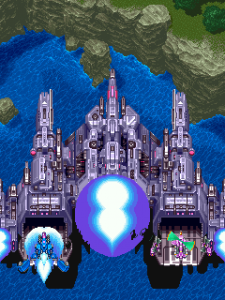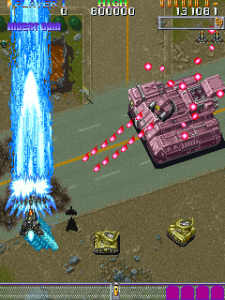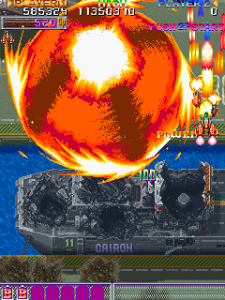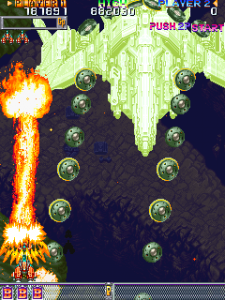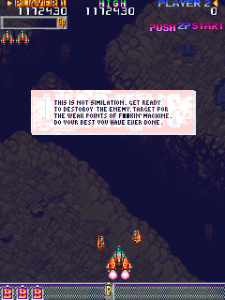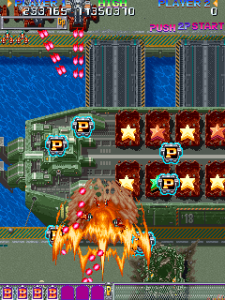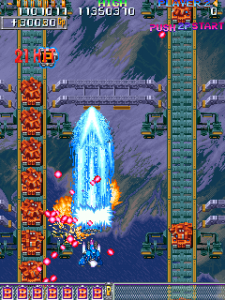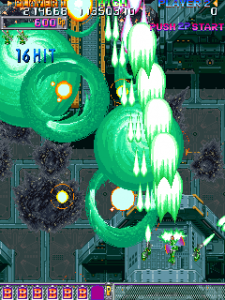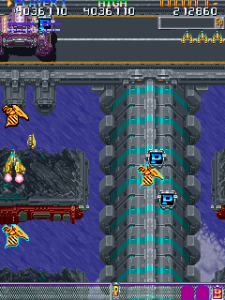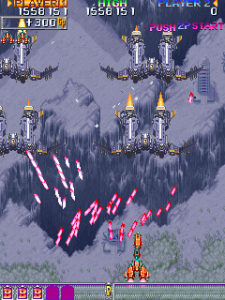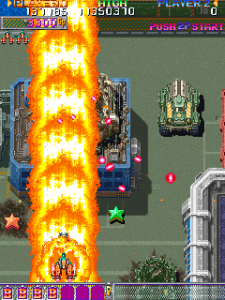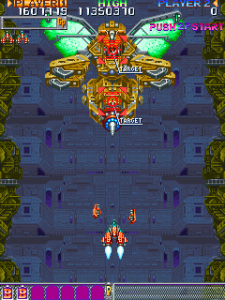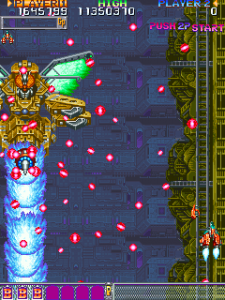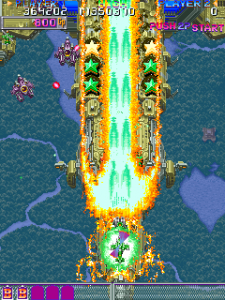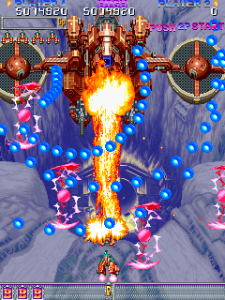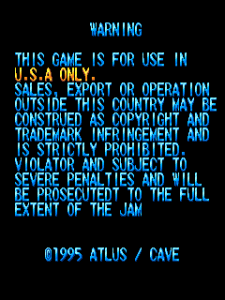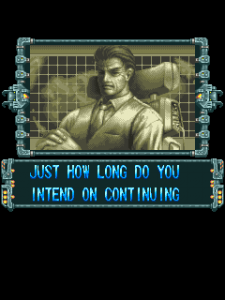At the time of writing, there is really only one series in recent memory that has been almost universally accepted as “hard”, and that is Souls series (Demon’s Souls, Dark Souls, Dark Souls II) by Japanese developer From Software. Of course, there have been plenty of other “hard” games in the past, Battletoads on the NES, Super Ghouls ‘n Ghosts on the Super Nintendo, and Ninja Gaiden Black on the original Xbox, just to name a few. Now, while all of the previously mentioned games are “hard”, in all instances the games can be made easier by repeated play. In doing so players will eventually gain complete memorization of enemy layouts and patterns, intricate knowledge of the game mechanics and its exploits, and the execution required to complete the game. It is very safe to say that all of these games were able to be cleared within a year of their release. Dodonpachi Daioujou Death Label, is a brutally hard game, yet by applying the same principles as before, players can one day eventually clear it. And a Japanese superplayer who goes by “MON” was the first person to clear it in 2010,・i>seven years after its initial release. Since then, there has only been one other person to clear the game. So, to put it bluntly, the Donpachi series is really bleepin hard!
In this particular case, Daioujou Death Label is just one gameplay mode of more than twenty other gameplay modes across fourteen games, and is, without question, the hardest one of them all. There are so many different of gameplay modes and difficulty settings across the series that allow for players of all skill levels to have a really good chance at clearing with relatively little time invested. Despite the overarching themes of war, genocide, betrayal, and overcoming the overwhelming enemy forces that appear in each game, above all else, the Donpachi series is about having fun. It’s hard, and it is not afraid to remind the player of this at any given second, but fun is what keeps the players playing, difficulty only serves to supplement that fact.
There is no consistency when it comes to the official spellings for each game, for example, Dodonpachi, DoDonPachi, Do-Don-Pachi, and Do DonPachi, all appear to be official spellings. The subtitles for some of the games don’t fare much better, with spellings such as Dai-Ou-Jou, DaiOuJou, and Daioujou, or Daifukkatsu and DaiFukkatsu, all being used in some official capacity. The final game of the series, Saidaioujou, seems to be the only consistent spelling. For the sake of consistency, this article will use “Dodonpachi” and its subtitles as single words.
In February of 1993, Japanese game developer Toaplan released Batsugun to Japanese arcades. The game would be met with high praise, and would later be cited as the game that defined many of the various tropes and characteristics that are present in every bullet-hell shoot-em-up created since. Sadly, Toaplan would close its doors soon after, leaving many developers suddenly out of work. One of these developers was a programmer named Tsuneki Ikeda, who with fellow now ex-Toaplan employees would found their own development studio, Cave Interactive Co. Ltd, more commonly known as Cave. As Cave was comprised of ex-Toaplan employees at that time, it makes sense that their inaugural game would be a Toaplan-style shooting game. Their first game is Donpachi (lit. “Leader Bee”),a “maniac shooter” in the vein of other Toaplan shoot-em-up, like Batsugun. Donpachi was first released in Japanese arcades in May of 1995, and in doing so, created a franchise that would see various releases and ports over the next eight years and across two console generations.
Story
Our story begins with a fresh recruit, the player, who has been selected to take part in a secret military program. The player’s first mission tasks them with successively assaulting five enemy strongholds. Of course, each stronghold is protected by an army, meaning the player’s mission will not be an easy one. Only after the player manages to somehow survive this mission do they learn the truth: the “enemies” they were fighting against were actually fellow candidates in the program, who sacrificed their lives so that the program would be successful. The goal of this program is to take the best fighter pilots from around the world, and turn them into super-soldiers by subjecting them to eight ruthless years of live-fire training against each other. The surviving pilots will have proven themselves to be the greatest pilots in the world, and become the founding members of mankind’s greatest military force: the Donpachi Squadron.
After completing the first five areas, the game takes the player on their final mission seven years later. The player is no longer a rookie, and their operator treats them as such. However, no one could have expected the surprise the commander had in store for the final test. After successfully destroying the five enemy strongholds one last time, the player faces yet another task. They must overcome the Taisabachi (Colonel Bee), a doomsday weapon capable of unimaginable destruction. Will the player overcome this awesome challenge, and become a member of the Donpachi Squadron? Or will the player be overwhelmed by this obstacle, becoming yet another sacrifice to the project?
Gameplay
Donpachi is a two-button game. The first button, the A button, serves two functions. Quickly pressing and releasing the A button causes the ship to fire the Shot. Since this is an old game, auto-fire systems weren’t built into the game, so players will have to mash on the A button to unleash a continuous stream of Shots. Holding the A button down causes the ship to fire a powerful Laser. While using the Laser, the player’s movement speed is reduced, but the player gains an Aura around their ship, and a sort of “after-image” trail when they move. This Aura has the same strength as the Laser, and is able to damage any enemies that come into contact with it. Pressing the B button will release a bomb.
There are two types of bombs: the Spread Bomb and the Laser Bomb. Regardless of the bomb type when used, the player’s ship becomes surrounded by an invincible shield for the bomb’s duration. If the A button is not held down when bombing, a Spread Bomb is released. Using the Spread Bomb not only clears the screen of any and all bullets during the blast, but damages all enemies on screen as well. Each ship’s has a unique Spread Bomb animation, but no matter which ship is selected, the Spread Bomb will create a large explosion somewhere on the screen, causing additional damage to that area in particular. If the player is using their Laser when they bomb, they instead release a devastating Laser Bomb, an attack so powerful it causes the ‘s ship to move backwards when fired during boss battles! (This can be negated by holding forward.) The Laser Bomb does not automatically destroy onscreen bullets, instead bullets are only destroyed when they come into contact with the Laser Bomb’s beam.
Players can choose from three different ship types at the start of the game, and can change ship types after continuing if the player loses all their lives. Each ship type has its own unique characteristics and quirks, so be sure to try them all to find the best fit for each player’s play style. The red ship (or yellow ship for Player 2) is the Type-A ship. The Type-A ship is the fastest of the three ships, with its Shot being a concentrated barrage straight ahead. It also has the least amount of movement reduction when using the Laser. To balance its speed, Type-A’s power is the weakest of the three. The green helicopter (pink for Player 2) is known as the Type-B ship. This ship is slower than the Type-A ship, but is faster than the Type-C. However, it’s the slowest of the three when it’s using its Laser. The Type-B Shot shoots two streams of bullets straight ahead, with its options also shooting a single stream forward when not moving sideways. The Type-B ship is unique in that moving left or right cause that side’s option to slowly alter its angle of attack the longer that direction is held, up to a maximum angle of 90°. However, its rotation is so slow, that the ship will be at the edge of the screen by the time it reaches the full 90°. Still, because of its adjusting angles, the Type-B ship can hit enemies from angles that the other two ships simply can’t. The third selectable ship in Donpachi is the blue (black for Player 2) Type-C ship. The Type-C has the slowest movement speed of the three, but makes up for this by having the strongest Shot and Laser in the game. The ship’s Shot fires a wide arced projectile straight ahead, with its options firing a similar projectile at a 30° angle. Despite its slower speed, the Type-C ship is good for beginners due to its strong Shot and Laser.
Donpachi starts the player off with three bombs in stock, three lives, and a rather wimpy Shot strength. Players can increase the Shot’s power and rate of fire and power by collecting the “P” power-up items that drop from certain enemies. There are a total of seven Shot levels. Every odd level will increase the Shot’s rate of fire, and every even numbered level will increase their Shot’s firepower and the Laser’s strength and width. Collecting an “MP” power-up will instantly set the ‘s shot to maximum power, but is only available after a player loses all their lives, or continuing. In Addition to the P and MP power-up items, there is also a “B” item, which will refill an empty bomb stock if one is available. Players can permanently increase the number of bombs they can carry (up to seven) by one every time they use three bombs. Player’s bombs are refilled at the start of each stage. Collecting a P power-up while at max power or a B item when at full bombs will award the player 10,000 points. Getting hit will cause the player to lose a life, scattering a number of power-up items and possibly even bomb items. When the player respawns, their shot level will be reset to zero, and they will have three bombs (regardless of how many they had before they died). This means that getting hit is very bad, and can quickly end an entire credit if the player dies in a bad place. While it is possible to collect some of the scattered power-ups during the respawn’s invincibility time, it is very hard to collect all of them, and attempting to do so will likely lead to another untimely death.
For its age, Donpachi is a surprisingly deep game, containing some advanced mechanics that might not be apparent at first. The first advanced mechanic is the game’s internal Rank system. As the game goes on, the game may suddenly become more difficult (more so than the gradual rise in difficulty). This sudden spike in difficulty is due to the Rank increasing. Rank is determined by how long the player has stayed alive, and if they have used a bomb. If the player has used a bomb, then it becomes how many they have in their total stock, and how many they have used. The Rank decreases by one level (if possible) when a player loses a life, and is automatically set to Easy when the player is on their last life.
Outside of bombing or dying, there is one other way to cancel enemy bullets onscreen. An important fact is that enemies can only shoot if they are visible on screen; in Donpachi the viewable space of the game screen is actually smaller than the width of the map (about 10% smaller). This means that although enemies may spawn on the map, they may not be visible to the player, and thus, unable to fire any bullets. Although, there are some enemies that disobey this rule (in Area 4 and Area 5), these outliers can still be prevented from firing if the player gets within point-blank range. This method works because smaller enemies can’t fire if they are within point-blank range of the player, the larger enemies and bosses still will however, so be careful. Point-blank range is determined by the ‘s Laser Aura, if the enemy is within that area, they are within range.
After successfully completing the first five stages of Donpachi, the player is treated to a brief cut scene, followed by the messages “7 Years Later” and “Final Mission”. This is known as the “second loop”, where the enemy placement remains the same as the first loop, but the enemies are now more ferocious with their attacks, firing much denser bullet patterns than their first loop iterations. Additionally, when an enemy is destroyed in the second loop, it will spawn “suicide bullets” with their trajectory depending on the game’s current difficulty rank. It is possible to prevent these suicide bullets from spawning by destroying the enemy at point-blank range (within the Aura’s attack range). Completing the tenth and final area in the second loop has the player face off against Donpachi‘s final boss, Taisabachi. Destroying Taisabachi marks the actual completion of Area 10, and awards the player extra points for the number of bombs remaining, as well as the number of lives remaining.
On the default settings of Donpachi, players are awarded an extra ship at two million points, and can acquire a 1-Up in Area 4. When players reach the big red ship, do not bomb, and destroy all the smaller turrets on the ship. Once the player gets to the end of the big red ship, there will be a giant turret in the middle of the screen. Destroy the smaller turrets around it, and then destroy the large turret itself. If done correctly, and the player did not bomb during this section, there will be a 1-Up item in the remains of the giant turret.
Scoring
The main scoring system in Donpachi is the Get Point System, or GPS, and is located in the upper left corner of the screen (upper right for Player 2). The GPS is, for all intents and purposes, a chaining system, and a very strict one at that. Whenever a player destroys something, they have half a second to destroy something else. Fail to destroy something within the time limit, and the counter is reset to zero, ending the current combo chain. For scoring, the most important part of any chain is the first enemy destroyed, specifically, the point value associated with that enemy. This is because the total point value of a chain is the resulting summation of all the enemies destroyed during the chain (the HITs), multiplied by the point value of the first enemy in the chain. It is possible to continue or even start a chain by destroying pieces of scenery or debris, but these things have their own multiplier, and do not contribute to the enemy chain’s point value. Scenery by itself is worth zero points, but has a multiplier point value of 100 (similar to a small enemy). The debris chain is much simpler than the enemy chain, with the number of HITs being multiplied by 100, and then multiplied again by the value of the first destroyed enemy in the chain. The debris chain is really only used in Area 4 (and Area 9), and the short path between the Area 10 boss, and the final boss.
Donpachi also contains two “hidden” scoring systems, hidden in that they may not be apparent in their conditions or how they can be used at first glance. The first “hidden” scoring system is known as the Bomb Bonus. It’s very simple to explain, simply don’t use bombs, and players will receive huge score bonuses that increase at the end of each level. For example, the Bomb Bonus for each Area during the second loop is 5 million points! That said, it is very hard to get the Bomb Bonus without complete memorization of the enemy placement and their bullet patterns. Should the player bomb at any time during the game (or lose a life), they will no longer be able to receive the Bomb Bonus, instead receiving a much smaller bonus based on the total number of bombs they can carry, and how many of them are in stock. The second hidden scoring system is one that players may stumble upon by accident; that is, the thirteen hidden bee items that are located within each area. Players can reveal the golden bee items a few different ways. For the bee items hidden within the stage, their specific location can be found by hovering over them, and can be revealed for pickup by either hitting the item’s location with the tip of the Laser, or by launching a Spread Bomb while that area is on screen. The other place bee items can be hiding is within destructible sections of large ships and bosses, and will appear regardless of how the section was destroyed. Collecting the first bee item awards 100 points, and raises the point value of the remaining bees, with the thirteenth bee item awarding 100,000 points. Losing a life will reset the counter back to 100 points. Collecting a bee item also adds a hit to the GPS. While not a hidden scoring system, the star items are worth 300 points each, and will also add to the HIT counter if they are revealed during a chain.
Now that the scoring systems of Donpachi have been explained, it is now time to detail how to use these various systems to maximize a player’s scoring potential, and achieve high-scores. But first, a quick breakdown of the importance of each scoring system. In a theoretically “perfect run”, the largest percentage of a player’s score will come from chaining, followed by the Bomb Bonus, followed by the Bee Bonus, with the Stars contributing the smallest amount to the total score. There are some other things, such as the extra lives, point value, boss destruction value, and picking up a power-up at max power for points, but those are very minor in importance to the score.
Simply put, it is not possible to chain an entire stage in Donpachi, as it is in future installments of the series, due to the enemy placement. Because of this, it is important to maximize the number of HITs in each possible scoring chain, preferably starting from a large enemy if possible. Players can start with debris or scenery, but their first kill should try to be a large enemy for maximum points. This can be done by performing the counter-intuitive action of not instantly killing enemies as they appear on screen, instead, waiting until the last possible second to destroy an enemy, so that the next wave will start (or has started) to make an even larger combo than before. The other key to scoring is to not bomb (or die). Although difficult, the rewards from the Bomb Bonus are well worth it, and can easily make up forty percent of a player’s final score. If the player does bomb, they might as well bomb to their heart’s content, as the bonus points for the bomb-stock are so insignificant compared to the Bomb Bonus. The hidden bee icons are fine, but they contribute such a small portion of the overall score, it’s no big deal if the player misses one or two.
Sounds and Music
The music in Donpachi was composed by Ryuichi Yabuki, and can be described as being in the style of a “military march”, with a few upbeat electronica tracks in the mix to switch things up. While the musical selection is fitting, it’s ultimately unmemorable, likely due to the hardware limitations. Surprisingly, Donpachi features an English announcer, and he sounds great. He really adds to the overall feeling of the game, telling the player what they∥re up against, and even encouraging them to keep at it when the boss is almost destroyed. His best line is probably after the name entry screen, where he says “Thanks for playing this game… bye!” Sadly the announcer is the best part of Donpachi‘s audio, as everything else sounds badly compressed. Some of the game’s sound effects seem…off. The Laser Bomb, for example, sounds like steam escaping from a boiling tea kettle. The smaller enemy’s explosions are also very unsatisfying.
Final Thoughts on DonPachi
Donpachi is a solid first entry from the newly formed Cave, although a large amount of its success should be attributed to the company being formed from ex-Toaplan employees. However, the game seems to have an identity crisis; it was to be a Toaplan game, but it also wants to be its own type a game, namely, a Cave game. Donpachi is the first game released by Cave and it shows. The game is quite playable, but ultimately feels…unrefined. DonPachi created what would go on to become staples of the series, such as the emphasis on chaining, the hidden bees, even the ship types, shots, colors, the more difficult second loop and the game’s “secret” true final boss. All of these things were first introduced in Donpachi. But these very same things would go on to be tweaked and refined in future installments of the series. Because of this, the game should really only be played if players want to see where the series began, otherwise they should go play the sequel, Dodonpachi.
One final note, Donpachi does have its own share of Engrish, such as their incredible boss warning (captured in the image to the right) that reads:
“THIS IS NOT SIMILATION. GET READY TO DESTOROY THE ENEMY. TARGET FOR THE WEAK POINTS OF F**KIN’ MACHINE. DO YOUR BEST YOU HAVE EVER DONE”.
Or the phrase “Why don’t you try hard?” on the Game Over screen. There is also the copyright screen where “VIOLATOR…WILL BE PROSECUTEDT TO THE FULL EXTENT OF THE JAM”, that would appear again in Dodonpachi.
Sega Saturn Version Differences
The Sega Saturn version of DonPachi has more features and extras than the Sony PlayStation version of the game, despite coming out months before. Featuring the standard Arcade mode and a “Score Attack” mode, which is really just a stage-selectable training mode. Lastly, there are a few different gameplay and display options that the player can modify. For the display options, the game starts out in the horizontal “Yoko” Mode, and can be switched to the full-screen “Tate Mode” (turned 90°), and an interesting Tate (Pad Rotated) option. The Tate (Pad Rotated) option essentially turns DonPachi into a horizontal shoot-em-up when the television, not the game, is still in Yoko mode. What Cave didn’t know at the time is that certain vertical scrolling shmup patterns do not always translate well on a horizontal plane, so while it is an interesting mode, it’s nothing too special. While playing Yoko is fine, Tate is the preferred way to play this version of the game. Oddly enough, unique to the Saturn version is the six different difficulty settings: Easy, Little Easy, Normal, Hard, Very Hard, and Ultra Hard. By default, the Sega Saturn version of the game is set to “Little Easy” difficulty (it was Normal in arcades). This may seem insignificant, but plays a huge role when it comes to the rank (as dying lowers the rank by one level). The biggest complaint players have with the Saturn version of the DonPachi are the lengthy loading times between stages and modes. There is a tiny bit more slowdown in this version than the PlayStation or arcade versions, but it’s very minor. Due to the Saturn’s struggles with transparencies, certain effects have been altered (such as explosions) to use more colored pixels, than they did in the arcade version.
PlayStation Version Differences
Of the two console ports of DonPachi, the PlayStation version is considered to be the superior port of the two. The arcade version’s slowdown is more accurately emulated on the PlayStation version of the game than its Saturn counterpart. However, when players first boot up the game, something seems…off. That’s because the bottom third of the screen is missing by default. Players can (and should) change the game’s display setting in the game’s option menu before anything else. There are a total of four options: Yoko (320x 240), Yoko (240×240), Tate (Yoko), and Tate. The default setting is Yoko (320×240), and should be promptly switched to Tate, even if players have to rotate their television to play it properly. The Tate (Yoko) option is the same “horizontal shoot-em-up” version of the game found in the Sega Saturn version.
Exclusive to the PlayStation version, players can adjust the number of lives they start with. By default, the PlayStation version of DonPachi is set to “Easy” difficulty (it was Normal in arcades). Note that there are only four difficulty settings in this version, the same as the arcade version. Now, why is it so important to play the PlayStation version of DonPachi in Tate mode? There are two reasons, the first is that playing in Yoko mode causes there to be less vertical space, making it feel really cramped. To alleviate this, players can forcibly move the camera up and down, similar to how it can be moved left and right, but that creates a brand new issue: the “wobble.” See, DonPachi is always scrolling down towards the bottom of the screen. So when the player moves their ship up or down, the camera moves itself to show that visible portion of the map, but the screen is still scrolling at the same time, ultimately creating a sort of “wobbling” effect that is incredibly disorienting and not enjoyable to experience. The PlayStation version of DonPachi does not feature any sort of training mode like in the Saturn version. The PlayStation version does feature faster load times than the Saturn version of the game.
Final Thoughts On The Ports
Sadly, the audio quality is much worse than the arcade version, somehow managing to become even more compressed and distorted. The once crisp and clear operator can now hard to understand at times, which is a shame. Audio quality aside, both versions of the game play quite well in Tate mode. The PlayStation version of DonPachi is closer to the original arcade release, providing a smoother gameplay experience than the Saturn version of the game. The audio also sounds clearer on the PlayStation version. The Saturn version does have the option to train on specific stages, something the PlayStation version lacks. Both ports have the ability to turn the slowdown on or off (called “wait” in the option menu), but the Saturn version will still run slower and have longer load times than the PlayStation version. Still, both versions are rather respectable ports of the original arcade game. But this is only true in Tate mode, players should do their best to stay away from playing in Yoko mode if they can avoid it. Especially the PlayStation version, which just chops the bottom third of the screen off while in Yoko mode.
Links:
DonPachi 1CC A 1CC of Donpachi with the Type-A ship
Donpachi strategy thread from shmups.system11.org A great resource for learning about the game
DonPachi OST Playlist A YouTube playlist of the Donpachi Redbook OST
